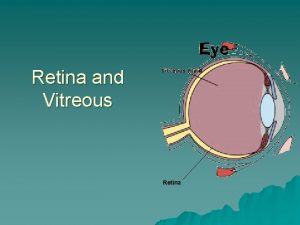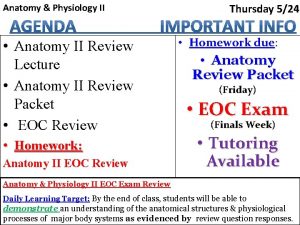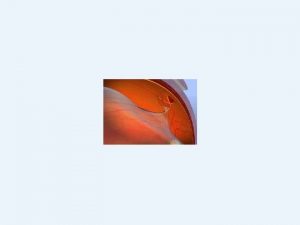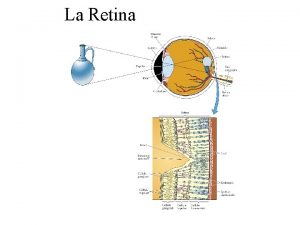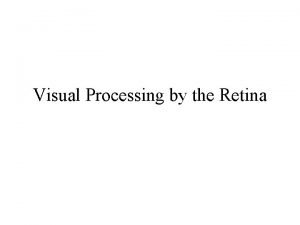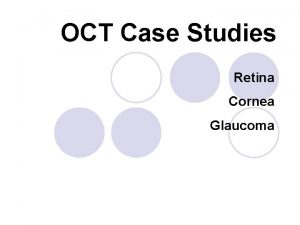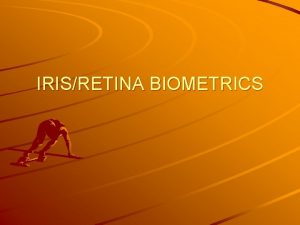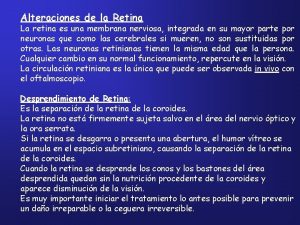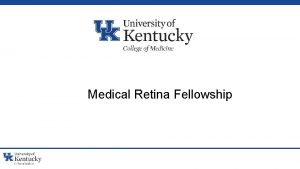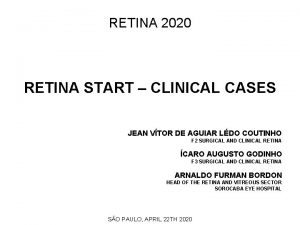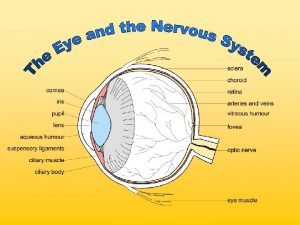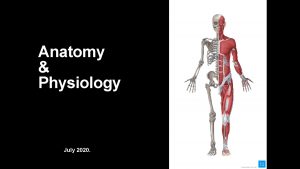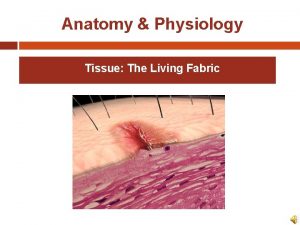Review of anatomy physiology of the Retina Dr
































- Slides: 32

Review of anatomy & physiology of the Retina Dr. Ayesha Abdullah 17. 12. 2015

Learning outcomes By the end of this lecture the students would be able to; • Correlate the structural organization of the retina with its functions and development. • Identify structural landmarks on retinal photographs. • Name the investigations commonly employed for the assessment of various categories of retinal disorders.

Camera and the eye

• Unlike the image from a camera the resolution of the retinal image is not uniform. • Why? • What is the result? • There about 100 times more photoreceptors than the Ganglion cells. • Retina compresses images as unlike the camera.

Anatomical landmarks of the retina



Normal dimensions Anatomical characteristics Clinically Observable characteristics Optic disc Place where the optic nerve fibers leave the retina. It is devoid of rods and cones hence the blind spot. Contains the central retinal artery and vein It’s a pale disc like structure with vessels emerging out of its center called the cup. Its about 1. 5 mm in size. Macula It is the area where the ganglion cells are two layered. Contains the xanthophyl pigment giving it the pigmented look. It is about 5. 5 mm in diameter (3. 5 disc diameter/ 180 of visual angle). Roughly the area between the arterial arcades. Fovea A depression in the inner retinal surface. It contains cones only. The inner nuclear layer and the ganglion cell layer is absent. A concave central retinal depression about the same size as the disc (1. 5 mm) The thickest part of the retina Area surrounding the fovea Foveola Parafovea





Histological structure of the retina



Development of the retina

Functions of the retina Light perception Brightness appreciation Contrast sensitivity Two point discrimination and appreciation of details • Colour perception • Light and dark adaptation • Circadian rhythms & hormonal balance • •

Some important facts 1. There about 150 million receptors and only 1 million optic nerve fibers, there must be convergence and thus mixing of signals 2. The horizontal action of the horizontal and amacrine cells can allow one area of the retina to control another (e. g. , one stimulus inhibiting another). This inhibition is key to the sum of messages sent to the higher centers of the brain. 3. The response of cones to various wavelengths of light is called their spectral sensitivity 4. There are blue, green, and red cones but more accurately short, medium, and long wavelength sensitive cone subgroups- trichromatic vision

Some important facts 5. The receptive field of a sensory neuron is a region of space in which the presence of a stimulus will alter the firing of that neuron 6. The receptive field of a Ganglion cell in the retina of the eye is composed of input from all of the photoreceptors which synapse with it, and a group of ganglion cells in turn forms the receptive field for a cell in the brain. This process is called convergence.

vitreous RPE



Rods & Cones • Rod System – Achromatic – High convergence – High light sensitivity – Low visual acuity • Cone System – Chromatic – Low convergence – Low light sensitivity – High visual acuity

Direction of visual impulse Direction of light


Investigations for retinal structural and functional assessment • Clinical assessment- Ophthalmoscopy

Ophthalmic investigations • • • Ultrasound –B & A scans Ocular coherence tomography (OCT) Angiography Elctroretinogram Elctro-oculogram


OCT

Angiography

Electroretinogram

Homework • What is the blood supply of the inner and outer retinal layers? • What makes the inner and outer retinal blood barriers and what is their significance? • Why light has to travel through all the layers before generating the sensation of vision?
 Anatomy and physiology of the retina
Anatomy and physiology of the retina Upper respiratory tract labeled
Upper respiratory tract labeled Tattoo anatomy and physiology
Tattoo anatomy and physiology International anatomy olympiad
International anatomy olympiad Perfect vs imperfect flower
Perfect vs imperfect flower Anatomy and physiology bone
Anatomy and physiology bone Peptic ulcer disease anatomy
Peptic ulcer disease anatomy Liver anatomy
Liver anatomy Epigastric region
Epigastric region Hypogastric region
Hypogastric region Red blood cells anatomy and physiology
Red blood cells anatomy and physiology Chapter 14 anatomy and physiology
Chapter 14 anatomy and physiology Human anatomy and physiology seventh edition marieb
Human anatomy and physiology seventh edition marieb Http://anatomy and physiology
Http://anatomy and physiology Chapter 1 introduction to human anatomy and physiology
Chapter 1 introduction to human anatomy and physiology Physiology of appendicitis
Physiology of appendicitis Aohs foundations of anatomy and physiology 1
Aohs foundations of anatomy and physiology 1 Aohs foundations of anatomy and physiology 1
Aohs foundations of anatomy and physiology 1 Anatomical planes
Anatomical planes Anatomy and physiology chapter 8 special senses
Anatomy and physiology chapter 8 special senses Chapter 13 anatomy and physiology of pregnancy
Chapter 13 anatomy and physiology of pregnancy Agriscience unit 26 self evaluation answers
Agriscience unit 26 self evaluation answers Science olympiad forensics cheat sheet
Science olympiad forensics cheat sheet Chapter 2 basic chemistry anatomy and physiology
Chapter 2 basic chemistry anatomy and physiology Anatomy and physiology of stomach ppt
Anatomy and physiology of stomach ppt Physiology
Physiology Anatomy and physiology chapter 7
Anatomy and physiology chapter 7 Chapter 14 the digestive system and body metabolism
Chapter 14 the digestive system and body metabolism Chapter 10 blood anatomy and physiology
Chapter 10 blood anatomy and physiology Aohs foundations of anatomy and physiology 1
Aohs foundations of anatomy and physiology 1 Aohs foundations of anatomy and physiology 1
Aohs foundations of anatomy and physiology 1 What produces bile
What produces bile Anatomy and physiology chapter 15
Anatomy and physiology chapter 15

































